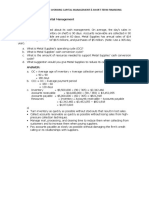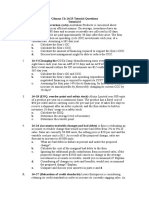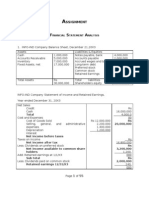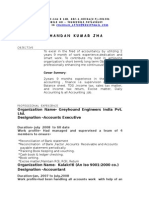Client Overview: Business Expenses
Client Overview: Business Expenses
Uploaded by
Dev DhakaCopyright:
Available Formats
Client Overview: Business Expenses
Client Overview: Business Expenses
Uploaded by
Dev DhakaOriginal Title
Copyright
Available Formats
Share this document
Did you find this document useful?
Is this content inappropriate?
Copyright:
Available Formats
Client Overview: Business Expenses
Client Overview: Business Expenses
Uploaded by
Dev DhakaCopyright:
Available Formats
Client overview
Our MFI is targeting a group of client base who want to increase their income generation through
starting a new business i.e., vegetable vendoring .
The following are estimated expenses of the vendor both household and business.
His family’s daily expenses include the following (the expenses are portrayed daily keeping in mind
the income of the vendor which is daily)
HOUSEHOLD EXPENSES (A family of 4 with 2 children)
Expenses Amount (in Rs.)
Food 120/-
Travel (to and fro) by bus for the members of 30/-
the family
Electric bill 10/-
Education 30/-
Miscellaneous( movie,drink,clothes,etc) 30/-
Total 220/-
BUSINESS EXPENSES:
Expenses Amount (in Rs.)
Electricity 10
Getting the produce from nearby market 100
Loss due to spoiling of the produce due to bad 60
weather or no sale
Pushcart Repairs (replacing tyres etc) (once in 50
3-4 months)
Total 170
TOTAL EXPENSES = 390
(HOUSEHOLD+BUSINESS)
Refill in Cost (in sales(in
numbers in a rupees) rupees)
day
Tomatoes(20 100 160
)
Onions(25) 250 375
Brinjal(12) 120 180
Potatoes(30) 180 240
Leafy 60 120
vegetables(2
0 bundles)
Lemon(5doz 60 120
ens)
Ginger and 30 60
garlic(1.5
kg)
Seasonal
vegetables
total 800 1255
Profit(per day):455
After meeting his expenses he would save: rs65
Therefore his weekly savings would be : Rs455
His monthly savings would be : Rs 1820
PRODUCT DESIGN AND FEATURES:
Abhilasha stands for “Aspiration”. This loan is designed for
economically active low-income households who have an
aspiration to improve their economic well-being. The loan is
offered in a group mechanism.
This is the most dominant loan product helping in driving financial
inclusion of low-income clients.This loan is mainly identified for
the vegetable vendors,keeping in mind the specific needs of the
vendors which are not being catered by the present products of
the MFI
Abhilasha targets three customer groups,they are:
1.customer base starting their business (with a push raft)
a. The loan amount would be Rs. 10000 to 15000.
b.the loan amount would cater to the needs of buying a raft , and the initial daily operational
expenses till the business stabilizes.
c.The loan term would be for 1 year with installment repayments every month
d.The interest rate charged for the loan would be 27% p.a
e.therefore his monthly installment would be(flate rate basis) would be rupees 1059
2.customer base who are street vendors
a.Target group who are already street vendors and want to upscale their business would be availed
with a loan of Rs.15000 -20000
b.The loan amount would cater to the needs of the vendors to rent a space and operational expenses
to expand their business.
c.The loan term would be for 12 months to 18 months with repayments every month
d.The interest rate charged for the loan would be 24% p.a
3.customer base who are from vegetable mandis
a.Target group who already have their shops in the vegetable mandi but want to expand their
business.
b.The loan amount be 30000 which would cater his needs of business expansion.
c.The loan term would be for 3 years.
d.The interest rate would be 22%p.a
One of the special feature of this product is that the clients can deposit(save) their money weekly
with the local representative of the MFI who would then deposit it with the MFI`s branch.
• The MFI is adopting a joint liability model to overcome the problem of default in repayment by any
of the members in the affinity group. The loans in the group can be given on individual basis whereas
the group can share the liability of default. This will prevent the problem of burdening a single
person due to his neighbor’s inability to repay. However, while creating the affinity groups, the MFI
will ensure that all the individuals in the group require a similar amount of loan such that the burden
created due to any member’s default is the same.
INTEREST RATE DETERMINATION
Three types of costs are associated with the lending process: the cost of funds for on-
lending, the cost of risk (loan loss), and administrative costs (identifying and screening
clients, . The costs of capital and loan loss risk vary proportionally with loan
size.Administrative costs are not proportional to loan size.
Interest rate: cost of funds +cost of risk +overhead cost +profit
Assumption:
cost of fund is at the rate of 12% p.a
Cost of risk would be higher for the new business starters and then decreases with the street
vendors and further decrease for the mandi shopkeepers.
So the assumed cost of risk is 8% for new starters,5 % for street vendors and 3 %for mandis
Overhead costs are 4%
Profit is 3%
So the interest rate goes as follows:
For new business starters: 12+8+4+3=27%
For street vendors to upgrade their business: 12+5+4+3=24%
For vegetable mandis shopkeepers: 12+3+4+3=22%
LOAN APPRAISAL:
Loan appraisal for micro lending has a number of complexities. Complexities arise due to lack of
data validation, high risk lending, financial constraints of the MFI, high transaction costs, etc. for
assessing the credit worthiness of clients, MFIs have two options: individual case by case basis of
evaluation by a loan officer or use of a standardized credit scoring model.
In the individual case-by-case method, a loan officer collects all relevant information for each client
and then decides on the credit worthiness of the client. This method offers the advantages of greater
accuracy of information and better decisions about the disbursement of loans. However, it involves
very high transaction cost, higher loan processing time and very highly skilled staff. Also, the loan
appraisal decision is completely dependent on the judgment of the loan officer.
Using a standardized credit-scoring model is simpler and less time-consuming. With a credit-scoring
model, a less qualified person can also assess the client’s credit worthiness and take a suitable
decision. The transaction costs and operating costs are reduced significantly. However, it suffers
from the problem of absence of on-site data validation giving rise to greater risk of default by the
clients.
You might also like
- Tutorial 3 WCM Updated fnc3101Document4 pagesTutorial 3 WCM Updated fnc3101Trick1 Haha100% (1)
- PS 2 Micro II 2022Document8 pagesPS 2 Micro II 2022TahseenNo ratings yet
- Wharton Casebook 2008 For Case Interview Practice - MasterTheCaseDocument84 pagesWharton Casebook 2008 For Case Interview Practice - MasterTheCaseMasterTheCase.com100% (1)
- NWCDocument5 pagesNWCKyla Ramos DiamsayNo ratings yet
- 15 ManagementDocument69 pages15 ManagementBelista25% (4)
- CH16HW TrierweilerDocument5 pagesCH16HW TrierweilerMax Trierweiler100% (1)
- PMO Maturity CubeDocument56 pagesPMO Maturity CubeSergio IvánNo ratings yet
- ОсновыЛогистикиЧасть1Document71 pagesОсновыЛогистикиЧасть1Ekaterina KarpovaNo ratings yet
- Chapter 1, DemandDocument16 pagesChapter 1, DemandRadhika JainNo ratings yet
- Working Capital MGTDocument17 pagesWorking Capital MGTJeffrey MooketsaneNo ratings yet
- Hdssdas 7878Document3 pagesHdssdas 7878vamshiyerrawarNo ratings yet
- Receivables ManagementDocument4 pagesReceivables ManagementVaibhav MoondraNo ratings yet
- NDCC Consulting CasebookDocument185 pagesNDCC Consulting CasebookjonnyNo ratings yet
- Cosmatics & StationaryDocument5 pagesCosmatics & Stationarykartik DebnathNo ratings yet
- Receivable Management ExerciseDocument3 pagesReceivable Management ExerciseChristoper SalvinoNo ratings yet
- CH 10 PPT Examples Relaxing Credit Standards QnssolnsDocument8 pagesCH 10 PPT Examples Relaxing Credit Standards QnssolnsRiri FahraniNo ratings yet
- Caribbean Internet Café: Fixed/Month Variable/Hour Start UpDocument2 pagesCaribbean Internet Café: Fixed/Month Variable/Hour Start UpShouib MehreyarNo ratings yet
- Promotion Study Material I To II and II To III-1Document131 pagesPromotion Study Material I To II and II To III-1Shuvajoy ChakrabortyNo ratings yet
- Masters of Business Administration Semester 2 MB0045 - Financial ManagementDocument9 pagesMasters of Business Administration Semester 2 MB0045 - Financial ManagementKumar GauravNo ratings yet
- Particulars Amount Amount Rs. (DR.) Rs. (DR.)Document14 pagesParticulars Amount Amount Rs. (DR.) Rs. (DR.)Alka DwivediNo ratings yet
- Gitman CH 14 15 QnsDocument3 pagesGitman CH 14 15 QnsFrancisCop100% (1)
- Chapter 1Document17 pagesChapter 1themonkeybuzzerNo ratings yet
- Practice Problems For Mid TermDocument6 pagesPractice Problems For Mid TermMohit ChawlaNo ratings yet
- Exam176 10Document5 pagesExam176 10Rabah ElmasriNo ratings yet
- LPPDocument28 pagesLPPRahul PathrabeNo ratings yet
- Flow ChartDocument20 pagesFlow ChartVivek SinghNo ratings yet
- FMG 22-IntroductionDocument22 pagesFMG 22-IntroductionPrateek GargNo ratings yet
- Human Resource Management in Textile IndDocument4 pagesHuman Resource Management in Textile IndravikantNo ratings yet
- Sebi Grade A 2020: Economics-Multiplier & AcceleratorDocument6 pagesSebi Grade A 2020: Economics-Multiplier & AcceleratorThabarak ShaikhNo ratings yet
- Test 3 Corprate FinanceDocument10 pagesTest 3 Corprate FinancekeelyNo ratings yet
- Special Decision Making HandoutDocument8 pagesSpecial Decision Making Handoutrashinisanchalani20No ratings yet
- 1 - Koyom Promotion Project 4Document5 pages1 - Koyom Promotion Project 4Gamachu TarikuNo ratings yet
- MachugaS Web12 5Document6 pagesMachugaS Web12 5Muhammad WaqasNo ratings yet
- Financial Plan Lajpatrai 46480Document5 pagesFinancial Plan Lajpatrai 46480Ahsan MemonNo ratings yet
- 3rd Sem Nmims June 2020 Assignments SampleDocument54 pages3rd Sem Nmims June 2020 Assignments Samplerachit vishnoiNo ratings yet
- Conceptual AssignmentDocument3 pagesConceptual AssignmentAmitavNo ratings yet
- ME End TermDocument10 pagesME End TermAditya DhirNo ratings yet
- Unit V BAP 2023 1700566379097Document68 pagesUnit V BAP 2023 1700566379097kannandharani82No ratings yet
- MA2 (100 QS)Document30 pagesMA2 (100 QS)Alina NaeemNo ratings yet
- Responsibility Accounting Practice ProblemDocument4 pagesResponsibility Accounting Practice ProblemBeomiNo ratings yet
- Receivables Management: © Tata Mcgraw-Hill Publishing Company Limited, Financial ManagementDocument46 pagesReceivables Management: © Tata Mcgraw-Hill Publishing Company Limited, Financial Managementarchana_anuragi100% (1)
- Test 3 Fall Section HADocument5 pagesTest 3 Fall Section HAVin JohnNo ratings yet
- Bplan Coin LaundryDocument19 pagesBplan Coin LaundrySergiu CrazywolfNo ratings yet
- Cbse-Qb-Ch 5-Business ArithmeticDocument18 pagesCbse-Qb-Ch 5-Business Arithmeticgv4t47gx7dNo ratings yet
- 050_Devinta Aulia_PPT Manajemen Piutang_Minggu ke-4Document11 pages050_Devinta Aulia_PPT Manajemen Piutang_Minggu ke-4devinta.21050No ratings yet
- Receivables Management FinalDocument33 pagesReceivables Management Finalrajesh15588No ratings yet
- Cbse QB CH 5 Business ArithmeticDocument15 pagesCbse QB CH 5 Business ArithmeticVISHAL S. VNo ratings yet
- FM4 Part 2 Accounts Receivable and Inventory ManagementDocument20 pagesFM4 Part 2 Accounts Receivable and Inventory ManagementakatsukiescarroNo ratings yet
- Receivables ManagementDocument33 pagesReceivables ManagementArjun SanalNo ratings yet
- Lecture Questions-SolDocument5 pagesLecture Questions-SolRami RRKNo ratings yet
- Virgin Mobile Pricing and Launch in UsaDocument5 pagesVirgin Mobile Pricing and Launch in UsaHiamanshu SinghNo ratings yet
- Mock Exam SolutionDocument4 pagesMock Exam Solutionsu13092004No ratings yet
- ACC 604 Online Problem ListDocument16 pagesACC 604 Online Problem Listdani987yaNo ratings yet
- 404 - WCM ExerciseDocument9 pages404 - WCM ExerciseChloe Quirona Policios0% (2)
- Finance OverviewDocument19 pagesFinance OverviewyomoNo ratings yet
- Cosmatic & Stationary 3 Lak FullDocument8 pagesCosmatic & Stationary 3 Lak Fullkartik DebnathNo ratings yet
- Manual For Finance QuestionsDocument55 pagesManual For Finance QuestionsMShoaibUsmani100% (1)
- Corporate FinanceDocument10 pagesCorporate FinancesurimuskansuriNo ratings yet
- SHRT TRM FinxxxDocument9 pagesSHRT TRM FinxxxMamun RashidNo ratings yet
- Group Assigt - Answer MGT AccDocument46 pagesGroup Assigt - Answer MGT AccAmanuel Girma100% (1)
- 2017 International Comparison Program for Asia and the Pacific: Purchasing Power Parities and Real Expenditures—Results and MethodologyFrom Everand2017 International Comparison Program for Asia and the Pacific: Purchasing Power Parities and Real Expenditures—Results and MethodologyNo ratings yet
- A Comparative Analysis of Tax Administration in Asia and the Pacific—Sixth EditionFrom EverandA Comparative Analysis of Tax Administration in Asia and the Pacific—Sixth EditionNo ratings yet
- Cse Dec 21 Free Mock Test Series Subject: Setting Up of Business Entities and ClosureDocument5 pagesCse Dec 21 Free Mock Test Series Subject: Setting Up of Business Entities and ClosureSimran TrehanNo ratings yet
- Chapter 11Document12 pagesChapter 11Ya LunNo ratings yet
- AP 2022 Final Na FinalDocument20 pagesAP 2022 Final Na FinalJohn Carlo D. EngayNo ratings yet
- Resa Irr. Ra 9646Document17 pagesResa Irr. Ra 9646Israeli Tagalog-Brondial100% (1)
- CFO - IIM CourseDocument13 pagesCFO - IIM CourseRajesh RamakrishnaNo ratings yet
- First InvestmentsDocument4 pagesFirst InvestmentsNitin Kumar0% (1)
- Presentation On Mobile Operator: Robi Axiata LimitedDocument10 pagesPresentation On Mobile Operator: Robi Axiata LimitedMohammad Arif HasanNo ratings yet
- Curriculum VitaeDocument3 pagesCurriculum Vitaenaresh kumar singhNo ratings yet
- Abitante Fiore E Brochure Compressed MinDocument6 pagesAbitante Fiore E Brochure Compressed MinAkshat KhetanNo ratings yet
- HW 1 - Formulas and Functions - TasksDocument5 pagesHW 1 - Formulas and Functions - Taskshi i'm tunieNo ratings yet
- Competition Law Briefing - Uganda's New Competition ActDocument8 pagesCompetition Law Briefing - Uganda's New Competition ActCreative MindNo ratings yet
- Strategic Planning and The Marketing Management Process: Mcgraw-Hill/IrwinDocument31 pagesStrategic Planning and The Marketing Management Process: Mcgraw-Hill/IrwinMai MaiNo ratings yet
- Volume IDocument363 pagesVolume IMuhammad Usman HayatNo ratings yet
- Warehouse FunctionsDocument27 pagesWarehouse FunctionsSheila Ibay VillanuevaNo ratings yet
- 0.5 - . Inelastic: 1. P1 50 P2 60 Q1 100 Q2 90Document3 pages0.5 - . Inelastic: 1. P1 50 P2 60 Q1 100 Q2 90John Paul BarotNo ratings yet
- Break Even Analysis ThesisDocument7 pagesBreak Even Analysis Thesisangeljordancincinnati100% (2)
- Basic Knowledge Doing IE Job in GarmentsDocument2 pagesBasic Knowledge Doing IE Job in Garmentssoban adilNo ratings yet
- ConclusionDocument3 pagesConclusionAnimesh TiwariNo ratings yet
- SAP OEE 15.1 HelpDocument134 pagesSAP OEE 15.1 HelpPradeep KumarNo ratings yet
- Literature Review On Concurrent Engineering and Its ImplementationDocument6 pagesLiterature Review On Concurrent Engineering and Its Implementationpp3986No ratings yet
- Revised ChapterDocument8 pagesRevised ChapterCarl BaltazarNo ratings yet
- CRM - TescoDocument14 pagesCRM - TescoAmeera MuzammilNo ratings yet
- Memorandum Data PrintDocument51 pagesMemorandum Data PrintGabyyOstosPicon0% (1)
- Circular No. 1817 - FIFA Clearing House Operations Commencing On 16 November 2022 - ENDocument5 pagesCircular No. 1817 - FIFA Clearing House Operations Commencing On 16 November 2022 - ENUtkarshNo ratings yet
- Unit 16 PPB Ancillary ServicesDocument6 pagesUnit 16 PPB Ancillary ServicesSkreddyNo ratings yet
- Parallel Learning StructuresDocument10 pagesParallel Learning StructuresTunisha Jethwani100% (1)
- #219 17104-94 A Ave Edmonton, AB T5TDocument2 pages#219 17104-94 A Ave Edmonton, AB T5TmeeeshbNo ratings yet
- Chapter 7 Relevant CostsDocument55 pagesChapter 7 Relevant CostsnathalieroseNo ratings yet

























































































